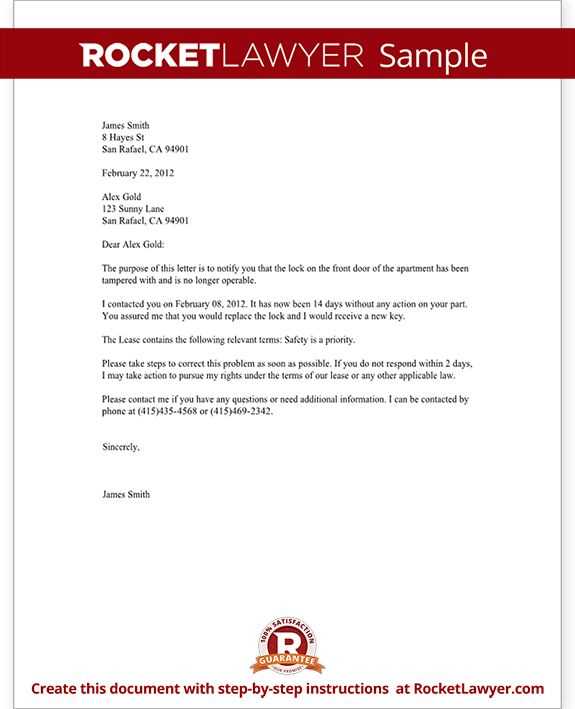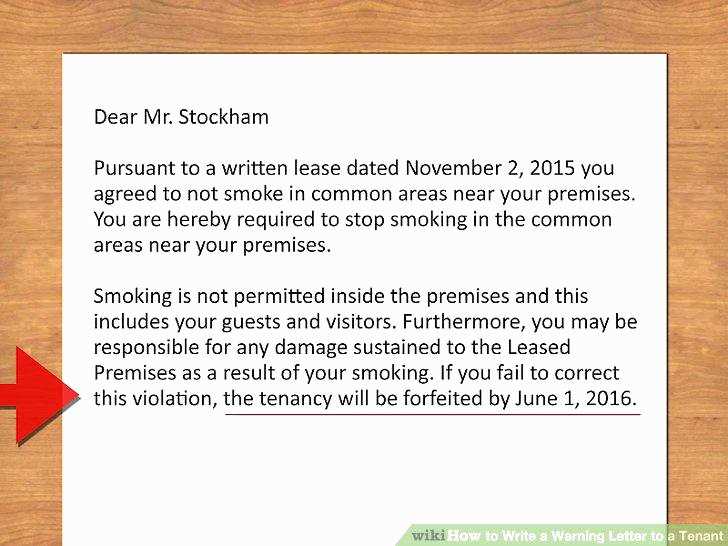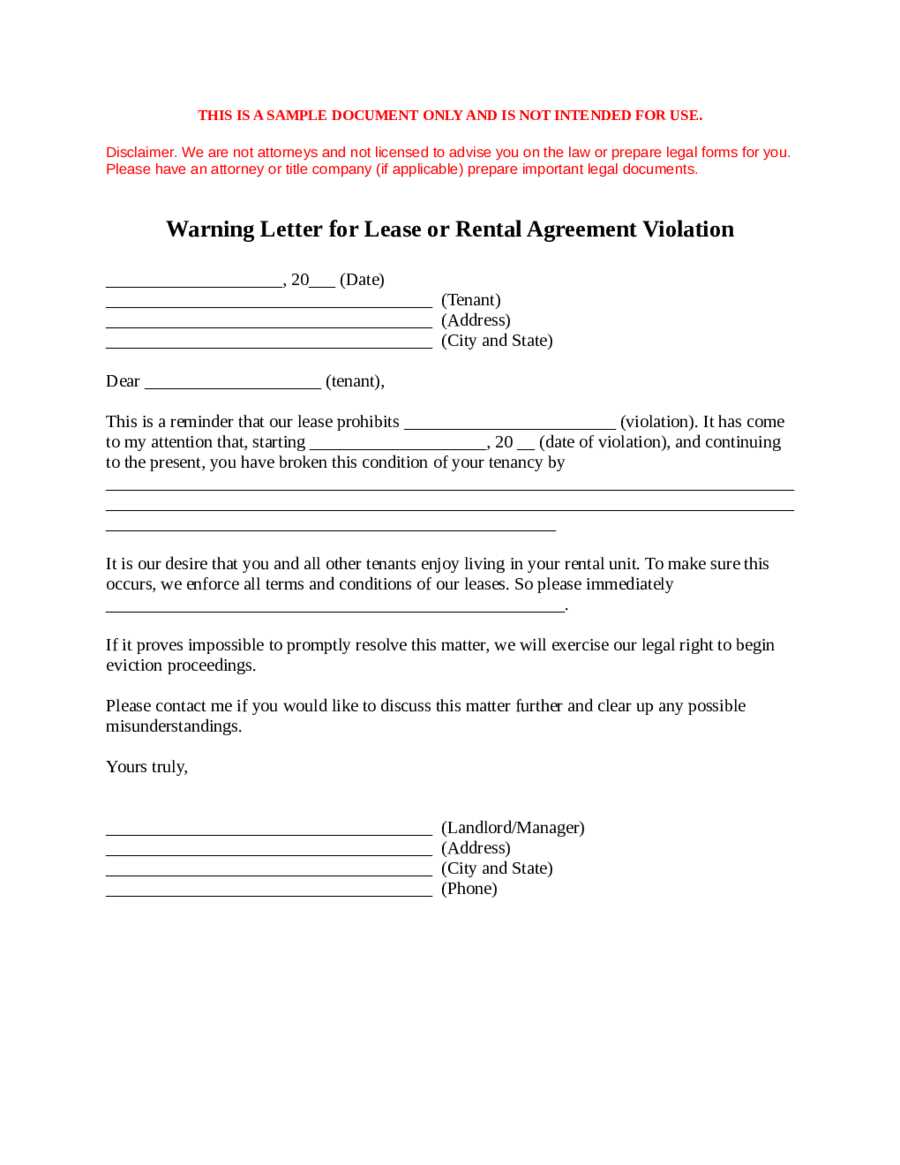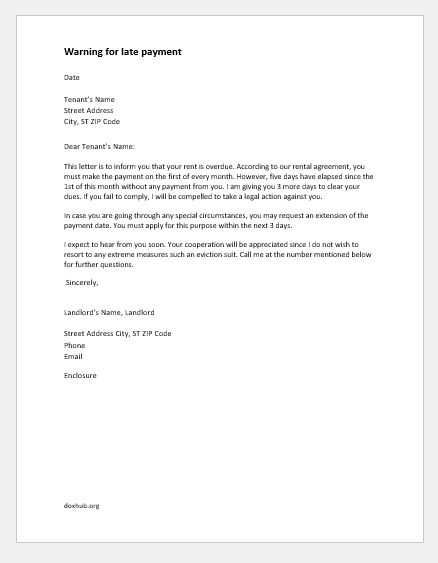Lease Violation Warning Letter Template for Landlords

Ensuring that tenants adhere to the terms of their agreement is essential for maintaining a smooth rental experience. When a tenant fails to comply with specific rules or obligations, it is crucial to address the issue promptly and professionally. Clear communication can prevent misunderstandings and promote a respectful landlord-tenant relationship.
Drafting an official communication is a key step in resolving any breach, as it formally notifies the tenant of the issue and provides a chance for them to correct their behavior. The content of such a document should be both clear and respectful, outlining the specific issue while maintaining a professional tone. A well-crafted document can also serve as a record for future reference, should further action be necessary.
In this guide, we will explore how to create an effective notification that protects both the landlord’s interests and the tenant’s rights. Understanding the correct structure and necessary components will help in crafting a message that is both legally sound and fair.
Importance of a Tenant Breach Notice
When a tenant fails to comply with the terms outlined in their agreement, it is essential to address the matter quickly and professionally. A formal notice serves as an official way to notify the tenant of the breach and offers them the opportunity to rectify the situation. This step is crucial not only for enforcing the rules but also for maintaining a harmonious relationship between both parties.
Protecting Your Rights
Sending a formal notification is an important way to ensure that the landlord’s rights are upheld. It establishes a clear record of communication, which can be vital in case the issue escalates or requires legal intervention. By addressing the issue promptly, a landlord can prevent further disruptions while still providing the tenant with an opportunity to correct their actions.
Maintaining Clear Communication
Clear communication helps to prevent misunderstandings and ensures both parties are on the same page. By formally documenting the breach, the tenant is made aware of the specific issue and the consequences of failing to address it. This transparency helps to avoid unnecessary conflicts and can result in a more amicable resolution.
When to Issue a Formal Notice
It’s important to address any breaches of the rental agreement in a timely and structured manner. Knowing when to formally notify a tenant of an issue can prevent further complications and ensure the situation is resolved efficiently. Acting too early may be unnecessary, while waiting too long may allow the problem to escalate.
Signs It’s Time to Act

There are several key indicators that suggest a formal notification is needed. These include:
- Failure to pay rent on time despite reminders.
- Damage to property or neglect of maintenance responsibilities.
- Engaging in illegal activities or actions that disrupt other tenants.
- Non-compliance with specific terms outlined in the agreement.
Handling Recurring Issues
If a tenant repeatedly disregards terms of the agreement after informal discussions or reminders, it may be time to send an official communication. This helps to establish a record of the issue, which can be useful if further legal action becomes necessary.
Key Components of an Official Notice

Creating an effective formal notice is essential for addressing tenant non-compliance. The document should clearly outline the issue, the expectations for resolution, and the potential consequences if the matter is not addressed. A well-structured notice ensures that both parties are on the same page and helps avoid further misunderstandings.
Each notice should include the following critical components to ensure it is both professional and legally sound:
- Tenant Information: Include the tenant’s full name, address, and the rental unit in question.
- Clear Description of the Issue: Specify the exact nature of the breach or non-compliance, referencing relevant sections of the agreement.
- Timeframe for Correction: Provide a reasonable period for the tenant to resolve the issue, typically between 7 and 30 days.
- Consequences of Inaction: Outline the potential next steps, such as fines, eviction, or legal action if the issue remains unresolved.
- Contact Information: Offer a way for the tenant to reach out for clarification or to discuss the issue further.
How to Customize Your Notice
Personalizing an official communication ensures that it is relevant to the specific situation and tailored to the individual tenant. Customization adds clarity and helps the tenant understand exactly what is expected of them. A generic notice may not address the nuances of a particular issue, potentially leading to confusion or a lack of compliance.
To effectively adapt your notice, consider the following points:
- Specific Breach Details: Clearly state the nature of the issue, including dates and facts that are directly relevant to the tenant’s actions.
- Tenant’s History: If the tenant has a history of similar problems, briefly mention this to show that the situation is being taken seriously.
- Desired Outcome: Be explicit about what actions the tenant needs to take and any deadlines for resolution.
- Consequences of Non-Compliance: State the potential repercussions in a firm yet respectful manner to encourage prompt action.
- Tone and Language: Keep the tone professional but direct. Avoid overly harsh or emotional language to maintain a constructive relationship.
Legal Considerations in Rental Notices
When drafting a formal communication regarding tenant non-compliance, it is crucial to ensure that the document aligns with local laws and regulations. Failing to comply with legal requirements can not only undermine the effectiveness of the notice but also expose the landlord to potential legal issues. It is essential to approach the process with caution and a clear understanding of legal standards.
There are several key legal factors to consider when sending an official notice:
- State and Local Laws: Different jurisdictions have specific rules regarding how and when notices should be issued, including timeframes for tenants to address the issue.
- Clear and Accurate Language: The notice should be precise and free of ambiguity to avoid misinterpretation. Any references to the rental agreement should be accurate and clear.
- Tenant Rights: Always consider the tenant’s legal rights. Ensure that the notice does not violate any protections provided under local tenant laws.
- Proper Delivery: Ensure the notice is delivered in a manner that complies with legal requirements, whether by mail, in person, or via electronic communication.
- Record-Keeping: Maintain a copy of the notice and any related correspondence for future reference, especially if legal action is required later.
Common Rental Issues to Address

There are several common issues that may arise during a tenancy that require attention. These problems can range from financial concerns to breaches of property care and other rules outlined in the rental agreement. Addressing these concerns promptly can help maintain a positive relationship between the tenant and landlord and prevent escalation into larger disputes.
| Issue | Description | Possible Actions |
|---|---|---|
| Late Rent Payments | Failure to pay rent on time, leading to overdue balances. | Send a formal reminder, impose late fees, or begin eviction proceedings if the issue persists. |
| Property Damage | Unapproved alterations or neglect of maintenance responsibilities. | Request repairs, charge for damages, or issue a corrective notice. |
| Noise Complaints | Excessive noise causing disturbance to other tenants or neighbors. | Send a notice warning of potential penalties, and request immediate action to resolve the issue. |
| Unauthorized Pets | Bringing pets into the property without approval. | Issue a notice requesting the removal of pets or apply penalties as specified in the agreement. |
| Illegal Activities | Engagement in illegal actions or criminal behavior on the premises. | Immediately address the behavior, with potential eviction or legal action if necessary. |